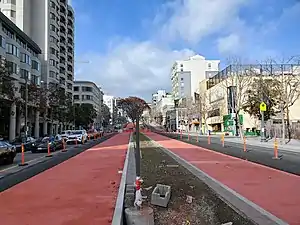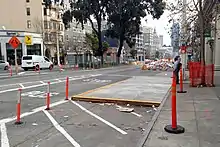Van Ness Bus Rapid Transit
The Van Ness Bus Rapid Transit project in San Francisco is designed to bring bus lanes to the thoroughfare from Mission Street to Union.[1] Dedicated bus lanes for the 47 Van Ness bus route, 49 Van Ness–Mission trolleybus route, and Golden Gate Transit are to be constructed along the median with 6-inch (152 mm) side platforms at stations for boarding and alighting passengers away from the curb.[2] Additionally, underground water and sewer replacement and landscaping will take place on Van Ness Avenue. The project is estimated to cost more than $300 million and be completed in late 2022 after several delays.
 Red lanes north of Golden Gate Avenue in December 2020 | ||||||||||||||||||||||||||||||||||||||||||||||||||||||||||||||||||||||||||||||||||||||||||||||||||||||||
| Locale | San Francisco, California, United States | |||||||||||||||||||||||||||||||||||||||||||||||||||||||||||||||||||||||||||||||||||||||||||||||||||||||
|---|---|---|---|---|---|---|---|---|---|---|---|---|---|---|---|---|---|---|---|---|---|---|---|---|---|---|---|---|---|---|---|---|---|---|---|---|---|---|---|---|---|---|---|---|---|---|---|---|---|---|---|---|---|---|---|---|---|---|---|---|---|---|---|---|---|---|---|---|---|---|---|---|---|---|---|---|---|---|---|---|---|---|---|---|---|---|---|---|---|---|---|---|---|---|---|---|---|---|---|---|---|---|---|---|
| Service type | Bus rapid transit | |||||||||||||||||||||||||||||||||||||||||||||||||||||||||||||||||||||||||||||||||||||||||||||||||||||||
| Routes | Muni: 30X, 47, 49, 76X, 90 | |||||||||||||||||||||||||||||||||||||||||||||||||||||||||||||||||||||||||||||||||||||||||||||||||||||||
| Operator | San Francisco Municipal Railway, Golden Gate Transit | |||||||||||||||||||||||||||||||||||||||||||||||||||||||||||||||||||||||||||||||||||||||||||||||||||||||
| Website | www | |||||||||||||||||||||||||||||||||||||||||||||||||||||||||||||||||||||||||||||||||||||||||||||||||||||||
| ||||||||||||||||||||||||||||||||||||||||||||||||||||||||||||||||||||||||||||||||||||||||||||||||||||||||
History

Streetcar service began on Van Ness Avenue in 1914 with the D Geary–Van Ness, F Stockton, and H Potrero routes, built to serve the Panama–Pacific International Exposition. Several other routes also ran on Van Ness for short periods: I Exposition in 1915, J Exposition in 1915–16, J Church in 1917–18, and K Ingleside in 1918. D and H service were discontinued in 1950; F service (which only used Van Ness between North Point and Chestnut) was discontinued in 1951.[3] The old overhead line poles were deemed too deteriorated to be retrofitted for modern use.[4]
Muni had planned a transit corridor improvement project on Van Ness since 1989 as part of the Proposition B sales tax expenditure plan.[5] The transit expansion part of the expenditure plan formed the basis of the 1995 Four Corridor Plan by the San Francisco County Transportation Authority (SFCTA), which planned for rail expansions along four priority corridors including Van Ness.[6] The corridors included the Bayshore Corridor which became the T Third Street Muni extension, and a proposed rail line along Geary Boulevard which ultimately became the Geary Bus Rapid Transit project. The third corridor to North Beach was implemented as the Central Subway project. The Van Ness corridor was to be the last of the four corridors, beyond the twenty year planning timeline of Proposition B.
In 2003, with Proposition B expiring in 2010, Proposition K was passed to provide additional sales tax funds. Its specified expenditure plan included bus rapid transit on the two corridors.[7] The SFCTA began to formally plan the project in 2004 after the passage of Proposition K, with a completion date then planned for 2012.[8] A feasibility study was completed in 2006, followed by the Draft Environmental Impact Statement/Environmental Impact Report (DEIS) in 2011.[9] The DEIS identified three possible designs: curb lanes, median lanes with side platforms, and median lanes with center platforms.[9]
The Final Environmental Impact Statement was released in July 2013, and approved by the SFCTA and SFMTA that September.[10] Its locally preferred alternative (LPA) design included median lanes with side platforms; changes from the DEIS included several platform locations and elimination of most left turn on Van Ness.[9] Both agencies also approved the addition of an optional southbound platform at Vallejo Street (the northbound platform was already added in the LPA).[10] The Federal Transit Administration approved the FEIS in December 2013. Addenda regarding parking loss and street tree removal were published in 2014 and 2016.[10]
The project ultimately broke ground in 2017, with completion then planned for 2019.[11] Issues encountered during construction delayed the completion date further to 2020, then again to late 2021.[12][13][14] Further delays in 2020 brought the estimated completion to 2022.[15]
Controversy
Some people who drive automobiles near the corridor have complained about possible changes in automobile traffic patterns and loss of automobile parking along the corridor.[1] Concerns that trees would be removed were met with plans to plant more trees on the route.[4] Residents supportive of the project have complained about continued delays in completing the project, and that the project is taking longer to complete than other similar projects in other cities because the SFMTA did not close the street to automobile traffic during construction.[16]
The use of 6 in (150 mm) low platforms with 12 in (300 mm) floor buses (rather than level boarding) has been criticized as bus rapid transit creep.[2]
References
- Tyler, Carolyn (18 November 2014). "CONCERNS RAISED OVER BRT LANES ON SAN FRANCISCO'S VAN NESS AVENUE". ABC. KGO-TV. Retrieved 22 May 2016.
- Cabanatuan, Michael (July 15, 2014). "Muni opposition hinders bus rapid transit". Hearst Communications. San Francisco Gate. Retrieved 22 May 2016.
- Stindt, Fred A. (October 1990). San Francisco's Century of Street Cars. pp. 180–189. ISBN 0961546514.
- Rodriguez, Joe Fitzgerald (January 15, 2016). "Trees, historic trolley poles to be removed for bus project". The San Francisco Examiner. Retrieved 22 May 2016.
- "San Francisco Voter Information Pamphlet" (PDF). November 7, 1989. Retrieved July 5, 2018.
- San Francisco County Transportation Authority (June 1995). "Four Corridor Plan". Retrieved July 5, 2018.
- "San Francisco Voter Information Pamphlet" (PDF). November 4, 2003. Retrieved May 8, 2018.
- Bialick, Aaron (December 2, 2011). "What's the Hold Up for Van Ness BRT?". Streetsblog SF. Retrieved July 5, 2018.
- "Chapter 2: Project Alternatives" (PDF). Final Environmental Impact Statement/Environmental Impact Report: Van Ness Avenue Bus Rapid Transit Project. San Francisco County Transportation Authority. July 2013. pp. 1–3.
- "Calendar Item No 10.3" (PDF). San Francisco Municipal Transportation Agency. February 10, 2020. p. 5.
- Chinn, Jerold (March 2, 2017). "Work begins on Van Ness transit corridor". SF Bay. Retrieved July 5, 2018.
- Rodriguez, Joe Fitzgerald (October 16, 2017). "Two-mile-long Van Ness bus lane project faces two-year delay". San Francisco Examiner. Retrieved July 5, 2018.
- Rodriguez, Joe Fitzgerald (April 23, 2018). "Van Ness Bus Rapid Transit construction delayed another 5 months". San Francisco Examiner.
- Matier, Phil (16 January 2019). "SF's Van Ness project nearly 2 years behind schedule, millions in cost overruns". San Francisco Chronicle. Retrieved 16 January 2019.
- Graf, Carly (3 December 2020). "SFMTA board scrutinizes Van Ness BRT spending". San Francisco Examiner. Retrieved 2 January 2021.
- https://www.sfchronicle.com/bayarea/article/City-says-it-s-back-on-track-with-long-delayed-14339907.php
External links
| Wikimedia Commons has media related to Van Ness Bus Rapid Transit. |